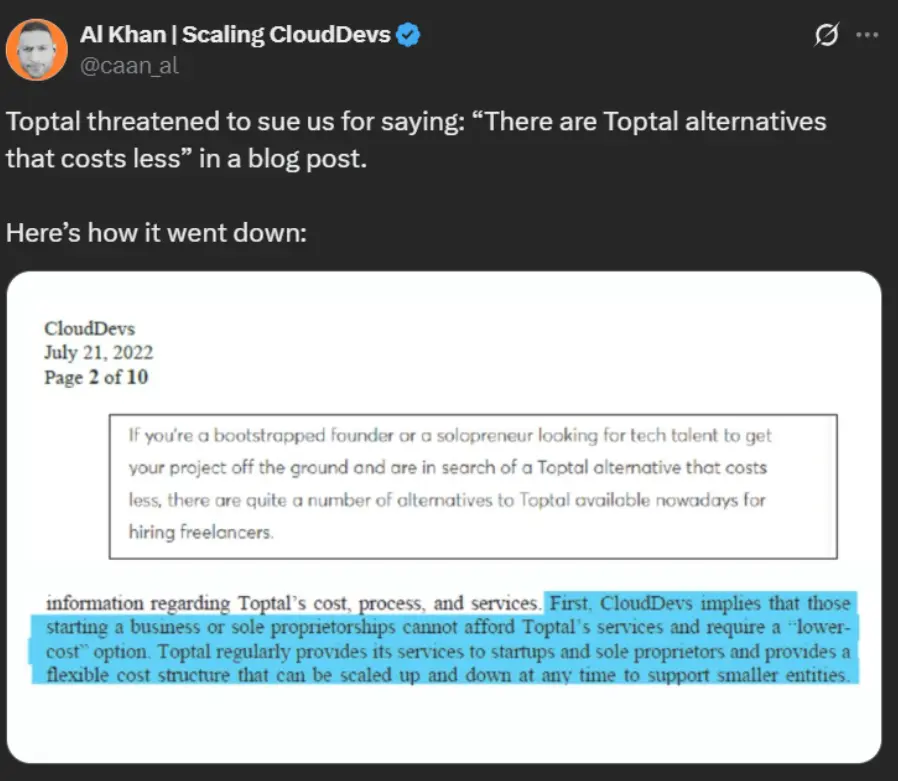Toptal Alternatives: The Best Developer Hiring Options for 2025
Today’s startups often scramble to hire skilled coders on short notice. Many think of Toptal as the first stop, after all, it boasts “top 3%” talent and quick matches. But that promise comes at a cost. Toptal requires a hefty deposit (about $500 up front), a $79/month platform fee, and developer rates that can exceed $150/hour (with Toptal tacking on a 40–50% hidden markup).
More alarmingly, some clients report that developers missed deadlines or delivered poor work, and found Toptal hard to engage for fixes. On the legal front, Toptal’s moves have drawn eyes. In 202,1 it sued one of its competitor platfoms (and several ex-employees) for allegedly stealing “a perfect clone” of its business. It even threatened CloudDevs, Toptal’s closest competitor, for talking about cheaper alternatives to Toptal on a blog! All this has driven many founders to steer clear of Toptal with many expressing their frustrations with the platform in community forums, and exploring other Toptal alternatives for their projects.

1. CloudDevs – Fast, Vetted Latin American Devs
CloudDevs is the best Toptal alternative when you want senior developers fast and affordably. Unlike Toptal’s global pool, CloudDevs focuses only on Latin America, which means 1–2 hour overlap with US working hours. They offer 500,000+ pre-vetted devs and designers on their platform. CloudDevs says it can match you with a vetted candidate in just 24 to 48 hours. And the rates are very attractive: senior LATAM engineers typically bill around $45–$75/hr (often ~60% cheaper than equivalent US talent). You’ll interview a shortlist of developers who have already passed technical tests and speak good English. Contracts are rolling and weekly, no long-term commitments. In fact, CloudDevs even offers a 7-day risk-free trial: if the person isn’t a fit, they’ll replace them or refund you.
Pros:
- Super-fast matching: Clients report being introduced to candidates within 24 hours.
- Rigorous vetting: Every dev/designer passes coding tests and English checks. You get senior engineers (7+ years exp) whose skills are pre-qualified.
- Big cost savings: Latin American rates are lower. CloudDevs advertises “save 60%” versus US prices In practice, $45–75/hr is typical.
- Time-zone overlap: LATAM team members work U.S. hours, easing collaboration.
- Flexible terms: Pay-as-you-go weekly contracts, no minimum commitment. Cancel anytime or swap talent after a short trial if needed.
Cons:
- LATAM-only: It’s Latin American talent only. (No Indian, European, or Asian devs here.) If you need someone physically elsewhere, CloudDevs isn’t a fit.
- Tech focus: CloudDevs is strictly devs and designers. (No marketers, finance people, etc.)
In short, CloudDevs is Toptal’s closest competitor with speedy, budget-friendly, pre-vetted talent from LATAM. Startups that are comfortable with an all-remote Latin team love it. If your project can be handled by a top engineer from Brazil, Mexico or Argentina, CloudDevs delivers top-notch code at a mid-range price.
2. LatHire – AI-Powered LATAM Full-Service Hiring
Lathire is the second best Toptal alternative. It’s another Latin American talent specialist, but with a wider scope. They claim an 800,000+ member network spanning tech and non-tech roles (devs, designers, PMs, marketers, even HR). Like CloudDevs, they use AI-driven screening, but with hand-guidance: their system ranks resumes and skill tests, then recruiters curate a shortlist. Lathire promises matches in about 24 hours too. The pitch: you’ll save “80% on salaries for generalist hires, 60% on tech hires” vs U.S. rates.
They also handle the headache of international employment. Lathire acts as the employer of record, managing contracts, payroll and legal compliance for you. So once you choose a candidate, they onboard them properly and you just pay Lathire (no foreign tax surprises). This full-service approach is great for founders who want a turnkey hiring solution without an HR department.
Pros:
- Huge talent pool: Over 800k candidates in LATAM, covering dozens of fields (dev, UX, marketing, ops, etc.). You won’t run out of niches.
- Smart vetting: Top ~3% of applicants make it through. They assess skills, language, and even do background checks. You get curated profiles, not random bids.
- Rapid matching: AI + recruiters promise to deliver candidates within a day or so (often under a week).
- Major cost cuts: By hiring in LATAM, you slash compensation. Lathire advertises up to 80% savings on non-tech salaries and ~60% on dev salaries.
E.g. an experienced Dev might be ~$30k/year salary instead of $100k in the US. - Full HR support: Lathire takes care of contracts, payroll, taxes, immigration (if needed), and compliance. You don’t have to set up foreign entities or mess with paperwork.
Cons:
- LATAM-only: All candidates are in Latin America. If you need someone in Europe or Asia, Lathire won’t help.
- Minimum scale: Lathire is geared to full-time roles (especially remote positions). For one-off freelance tasks, it’s overkill.
Lathire covers more roles, handles admin, and relies on AI/ML for faster search. It’s a top choice for U.S. companies wanting low-cost, English-fluent hires across functions. As one client said, it’s like Toptal’s vetting with a 24-hr match and a fraction of the pay.
3. Upwork – The Giant Freelance Marketplace
Upwork is the biggest name in freelancing. It has 12+ million freelancers worldwide, spanning literally every skill you can imagine (from Unity developers to Arabic translators). There’s no membership fee to browse; you just post a job and bids roll in within hours.
Pros:
- Enormous selection: Because anyone can join, you’ll find talent for any stack or role. Need a Python dev, or a Unity VR expert, or even a voice actor? Someone’s on Upwork. It’s the “wild west” in sheer choice.
- Flexible budgets: Freelancers set their own rates. You’ll see newbies at $5–$10/hr, intermediates at $25–$50, and seasoned architects at $100–$200+. This makes it easy to stay on budget by adjusting scope.
- Free job posting, low fees: Posting a job is free. Upwork only takes about a 3% processing fee on payments (compare that to Toptal’s 30–50% markup). Freelancers incur their own fees (20% on first $500 with a client), but clients mostly pay what the freelancer asks.
- Verified reviews: Every freelancer profile has ratings, reviews, and portfolios. You can often gauge quality by someone’s history. Upwork also holds payments in escrow, so you pay only for work you approve.
- Payment protection: For hourly work, Upwork’s time tracker can log what’s done. For fixed projects, money sits in escrow until milestones or final approval. This lowers risk for you.
Cons:
- No vetting: Upwork itself does nothing to test skills. Your job is to vet candidates. Expect to sift through dozens of proposals, conduct interviews, maybe give paid test tasks. As one commenter quipped, Upwork is a “freelancing wild west”.
- Hit-or-miss quality: Lower rates often mean less experience. Sure, top talent is on Upwork, but it’s mixed with many amateurs. On the flip side, Upwork fees for freelancers (up to 20%) sometimes push out experienced developers.
- Time investment: Without an agency model, you’ll be the hiring manager. For large projects this is fine, but if you need someone tomorrow, Upwork may take days of legwork.
Upwork shines for well-defined gigs where you can clarify deliverables upfront (think “build a landing page” or “create a logo”). Many small startups and agencies use Upwork regularly. Just remember: more freedom means more work for you in vetting and managing. When it comes to developer hiring, Upwork is the “no vetting, huge pool” end of the spectrum.
4. Fiverr & Fiverr Pro – Gig-Based Tasks
Fiverr is famous for its gig economy approach. Freelancers list fixed “gigs” (projects) starting as low as $5. Fiverr Pro is the premium tier where Fiverr vets the sellers (claiming only top ~3–7% get Pro status).
Pros:
- Quick, fixed-price gigs: If you know exactly what you need (a logo, a blog post, a short app feature), you can order it off-the-shelf. For example, you can find hundreds of WordPress tweak gigs or quick design jobs ready to launch.
- Fiverr Pro: For higher stakes, try Fiverr Pro. Pro sellers have been hand-selected by Fiverr (they’re typically experienced professionals). Hiring a Pro lets you tap vetted talent on Fiverr, often at surprisingly low cost.
- Very low entry cost: Even some Pro gigs are in the low hundreds of dollars. For example, a decent WordPress developer on Fiverr might charge $300/month, a bargain compared to Toptal.
Cons:
- 20% fee: Fiverr takes 20% of every transaction (from both buyers and sellers). This reduces what freelancers earn and can inflate prices or drive top talent away.
- Quality varies widely: Outside of Pro, anyone can post a gig, many are beginners or hobbyists. Even Pro quality can fluctuate by category. You’ll need to scrutinize portfolios and reviews carefully.
- Small scope: Fiverr is best for bite-sized tasks. It’s not built for multi-month product builds or complex projects. If you try to do big work, you’ll end up juggling many separate gig orders and still project-managing everything.
- Transactional vibe: Communication tends to be through Fiverr’s platform, and there’s usually less back-and-forth than with a dedicated freelancer or agency.
In practice, we often use Fiverr for very specific, bounded work like design assets or quick QA tests. For code-related tasks, Fiverr works best when the scope is crystal-clear. Many business owners view Fiverr (especially Pro) as a marketplace with an upmarket section. It won’t replace a fully managed service like Toptal or Gigster, but for short, defined tasks it can save you money. Just remember: it’s a gig-per-order system, not a long-term engineering partnership.
5. Freelancer.com – Budget-Friendly Freelance Pool
Freelancer.com is very similar to Upwork. It’s one of the oldest freelance marketplaces, boasting 50+ million users worldwide. You post a project or contest, and freelancers bid to win it. Like Upwork, it covers everything from coding to translation.
Pros:
- Huge global network: Millions of freelancers mean endless options. If Upwork is empty, Freelancer.com likely still has bidders.
- Design contests: Unique to Freelancer.com is the contest feature (e.g. design a logo, and the community submits entries). This can be handy if you want many ideas from which to pick a winner.
- Lower fees: Freelancer’s fee structure tends to be lighter on clients. For example, clients pay about 3% on fixed-price projects (and $5 for hourly), whereas Upwork normally charges 5% (though some US clients get 3% on Upwork). For freelancers, Freelancer charges ~10% of earnings.
- Flexible roles: Like Upwork, you’ll find not only developers but marketers, accountants, even voice actors.
Cons:
Same open marketplace issues: Anyone can apply, so you still must vet candidates. Quality is hit-or-miss. In fact, since Upwork took stronger market share, some of the more serious coders have left Freelancer.com, leaving many new or low-cost bidders. As the site notes, “lower barrier to entry” can mean “lower quality work”.
- Clutter & fees: Freelancer.com can spam you with bids unless you upgrade plans. And optional extras (like featured listings) can add costs.
- Platform quirks: The interface is not as polished as Upwork’s, and support for disputes or help tickets is slower.
Freelancer.com is essentially Upwork’s budget sibling. It’s a reasonable fallback if Upwork’s fees or projects limit are too high, or if you simply want another source of applicants. But don’t expect miracles: you’ll have to do your homework on any hire, and remember that with great low prices comes varied quality.
6. Gigster – End-to-End Dev Teams
Gigster is a completely different beast. Think of Gigster as a boutique on-demand development agency powered by AI. Rather than finding one freelancer, you describe your whole project, and Gigster assembles an entire team (engineers + designer + product manager) to build it. They even use AI tools to optimize matching.
Pros:
- Done-for-you teams: Gigster assigns a dedicated project manager to handle communication. You don’t vet or manage coders yourself. It’s like hiring a mini-agency: they design, build, test, and deliver the product.
- Elite talent: Gigster advertises that its network represents the top 1% of tech talent worldwide. Many engineers come from big tech companies or top universities. You’re essentially outsourcing your full dev team (with a promise of high quality).
- Structured process: Because it’s a full-service model, Gigster handles architecture, milestones, QA, etc. You get a finished product without having to stitch together multiple freelancers or suppliers.
Cons:
- Very high cost: Gigster is aimed at well-funded projects. Even their smallest projects have a $52,000+ baseline. Hourly rates run ~$100–150/hr. (By contrast, hiring an equivalent team via freelancers might be far cheaper, but you’d have to do the hiring and management yourself.)
- Overkill for small tasks: If all you need is a few features or a bug fixed, Gigster is too big. Its pricing and minimum scale mean it’s out of range unless you have a substantial budget (think enterprise app or full mobile product).
- Longer setup: While Gigster promises quick staffing (often in a couple of weeks), it’s still slower than onboarding a single contractor. It takes time to scope your project and build the team.
- No free trial: Once you kick off, you’re committed. There’s no short-term pilot, you pay per project from the get-go.
Gigster makes sense if you want a hands-off solution for a large or complex development project and can afford the price. It’s most suited to companies that would otherwise build an entire app in-house or hire a big software agency. For example, a startup looking to launch a finished MVP (complete with PM) could pay Gigster tens of thousands to do it under one roof. But for most small startups or simple tasks, the budget just isn’t there.
Picking the Right Toptal Alternative
There’s no single “best” alternative as it all depends on your priorities. Here’s a quick guide:
- Budget-conscious startups: Lean towards CloudDevs or Lathire. You still get a vetted shortlist and English-speaking developers, but at ~60–80% lower cost than U.S. rates. The only catch is all hires will be in Latin America. For many global products this isn’t a deal-breaker, since timezone overlap and skill levels are excellent in LATAM.
- Hiring managers who want convenience: CloudDevs, and Lathire take care of payroll and compliance for you. This “hands-off” approach is like having an agency but with freelance flexibility. If you dread HR paperwork or want a simple contract, these services are invaluable.
- DIY-savvy teams: If you have the time to sift candidates, Upwork or Freelancer.com offer unmatched variety. These platforms let you hand-pick specialists (blockchain devs, game devs, etc.) at almost any budget. Just factor in several days of interviewing and test tasks, you won’t get instant matches.
- One-off tasks/design work: Fiverr (especially Fiverr Pro) is great for fixed-scope gigs. Need a one-time logo, a quick script, or a landing page? Many such jobs can be done cheaply here. We often use Fiverr for small design jobs or routine tasks that don’t require a long commitment.
- Major product builds at enterprise level: If you have a big budget and need a whole team, Gigster could be your answer. They’ll assemble developers and a project manager to deliver a finished product. But be prepared to spend tens (or hundreds) of thousands.
Ultimately, it’s about trade-offs. Are you willing to trade some vetting for lower cost? (Then Upwork/Fiverr is fine.) Do you need speed above all? (CloudDevs/Lathire claim 24h matching.
As one tech blog put it, there’s a spectrum, from open marketplaces (flexible, cheap, self-vetted) to boutique networks (expensive, hand-vetted). My advice: weigh your priorities. For many startups, CloudDevs and Lathire hit a sweet spot for those seeking Toptal alternatives for vetted talent and big savings, which is why they’re gaining traction. That said, options like Upwork or Fiverr are always there if you just need lots of candidates at the lowest price.
Whatever route you take, remember: you do have choices beyond Toptal. Each of the platforms above has real success stories, and many can give you great developers (and designers) for far less than Toptal’s price. Don’t get locked into one marketplace, in 2025 the smart move is to shop around until you find the right fit for your team and project.



